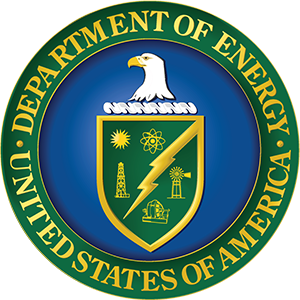Overview
Within This Page
Archives and Record Storage buildings are facilities that provide a proper environment for the purpose of storing records and materials that require permanent protection for historic and lifetime storage, upkeep, and preservation. Archives and Record Storage buildings must be high-performance with systems designed to operate permanently at a very high level with zero tolerance for failure. The often irreplaceable nature of the materials to be permanently stored and preserved in this type of building requires a life-cycle analysis and approach to its design and construction, with extensive redundancy in its building systems.
This building type must be designed to accommodate the loads of the materials to be stored; the sensitive environmental needs of different materials to be permanently stored and preserved; the functional efficiency, safety, security, and comfort of the visiting public and operating personnel; and the protection of the archived materials from fire, water, and man-made threats.
To accomplish this complex mission, these buildings benefit from an inclusive, holistic, integrated or whole building design approach that optimizes and balances the various design objectives to achieve the desired high-performance building. This process involves all building stakeholders and design professionals from the beginning of the project and throughout every other project phase. See WBDG Engage the Integrated Design Process.
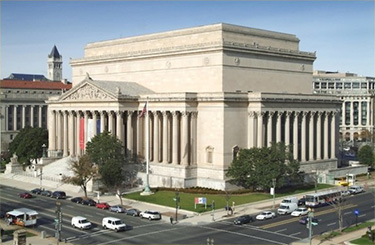
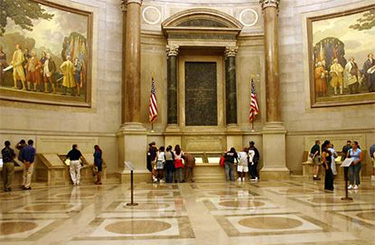
The National Archives building in Washington, DC was designed by renowned architect John Russell Pope as a temple to history and was completed in 1935. Pope wanted the architecture of the National Archives to reflect the significance, security, and permanence of the records held therein. Photo Credit: National Archives Museum
The majestic domed ceiling of the Rotunda, rising 70 feet above the floor, and 40-foot-tall bronze doors contribute to the feelings of awe and reverence experienced by visitors to this magnificent space. For more information on the history of the building click here. Photo Credit: National Archives Museum
Building Attributes
An Archives and Record Storage building must have working environments that are safe, secure, healthy, comfortable, durable, aesthetically pleasing, and be accessible. Administrative office space, archival and preservation office space, and permanent storage space for the stored archival and record materials must be accommodated. Important design issues for Archives and Record Storage Buildings are:
- Storage of archived materials to maximize efficiency, utilize building cubic space
- Flexibility for change of mission, new materials to be stored, and archival technologies
- Provision for archives expansion-vertically, horizontally
- Protection of the archived materials is a principal design driver for this building type
- Compartmentalization of storage areas to limit involved area of catastrophic loss in case of fire or system failure
- Fire protection of the stored materials
- Safety of staff and visitor occupants
- Temperature and humidity requirements that might vary for different types of materials stored in archival areas and in the archival/preservation office areas
- Daylighting for employee amenity, but not that would harm archival materials or adversely affect sensitive indoor environmental conditions
- Controlled access to archive storage areas
- Secure and safe loading and receiving areas
- Secure and controlled public/researcher access
Types and Attributes of Spaces
An Archives and Record Storage building incorporates a number of space types to meet the needs of staff and visitors. These spaces and their attributes may include:
Offices
- Administrative Offices: May be private and/or semi-private acoustically and/or visually
- Archival Office Areas: May require environmentally separate spaces for preservation and curatorial operations handling different materials, may require specialized furnishings and equipment, all secure from unauthorized public/visitor access
- Secure Access Corridor: Provide from archival office areas to archive spaces
- Secured Visitor/Researcher Office(s): To view archival materials: consider several "eyes-on" security vantage points, i.e., viewing glass from office reception and from nearby administrative office areas and/or CCTV cameras
- Archival Materials Storage: For materials used by staff for curatorial and preservation office operations. May require special/separated environmental conditions for different materials being processed
- Staff Sanitary Facilities
Visitor Support Spaces
- Lobby: Provide a central location for the building entrance containing directory, schedules, and general information. Consider including a retail shop to support future exhibits, public programs, and educational initiatives. See display considerations below.
- Security: Provide adequate space for security investigation station at entrance. Consider lockers for visitor personal packages/bags.
- Consider separate circulation and access paths for public visitors/tourists who will not need to see archival materials versus scholars/researchers who will.
- Scholar/Researcher Access: Provide to secured space in office area.
- Archival Display Case or Gallery: Display of selected archival items for visitors. Consider a display case(s) or a gallery depending on number/frequency of visitors.
- Visitor Sanitary Facilities
Employee Support Spaces
- Employee Entrance from Parking Area or Street: Consider separate employee and public entrances.
- Cafeteria Lunch Room Area, or Vending Machines: Locate to inhibit food, liquids, moisture, chemicals, and food waste from entering the archives and archival office areas.
- Employee Sanitary Facilities
- Exit: Provide access to outside parking spaces, enclosed parking area, or public transportation if applicable.
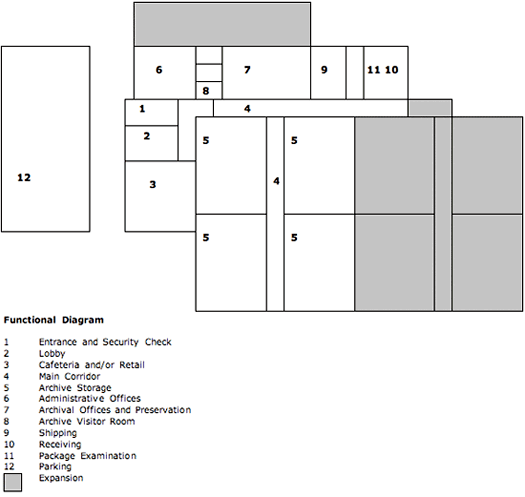
Archival Storage Spaces
- Compartmented Storage Spaces: Consider fire protection and egress life safety requirements, and distinct environmental requirements of different stored materials. No windows, skylights, roof penetrations, or rooftop mounted equipment should occur within/above the compartmented archive spaces.
- Structural Loading: Designers should consider wet weight of stored materials in the event of sprinkler activation.
- Configuration of Storage Spaces: This is dependent on size and nature of objects to be stored: flat or volumetric, physical composition of archived material, and frequency of use/access to stored materials.
- Efficiency: Design storage spaces efficiently to minimize space given over to aisles.
- Storage Methods: These can have a large impact on the size and configuration of storage spaces, with large cost implications for building and/or storage equipment as well.
- Future Planning: It is generally less expensive to increase building height than footprint area for the same amount of volume of stored materials. This is especially true in consideration of planning for future expansion of storage space.
- Interactions: Consider the interaction between building design and selection of storage methods that will affect the height and volume of storage spaces, weight and structural loading, accessibility, and fire protection measures.
- Multi-Story Storage: Consider the impacts of multi-story archive storage on fire protection of the structure and heavy foundation design, and the ability for fire fighters to access fires and adequately ventilate heat and smoke.
- Storage Systems: Consider the impacts of storage systems on methods of fire protection: open vs. solid shelving, flue space for sprinkler water penetration, need for in-rack/shelf/cabinet sprinkler heads, effect of water on stored material, and smoke and heat ventilation.
- Storage Methods: They may consist of all or combinations of:
- Open steel shelving with archive boxes of stored record materials or open volumetric materials
- File cabinets-letter, legal, or flat files for drawings, art materials
- High-density horizontal sliding storage systems and/or carousels
- High-density vertical storage systems and carousels:
- Note that vertical carousels can bring all stored materials in the carousel to a sitting stationary operator, and are thus accessible.
- Such systems can be very expensive and are used in a most cost-effective manner for materials needing frequent access.
- Cost: The cost of high-density storage systems should be examined in context with the offsetting reduced cost of a smaller building footprint or building volume.
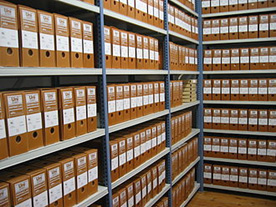
Shelved record boxes of an archive. Photo Credit: Wikipedia, CC BY-SA 3.0
Archive Access Corridor(s)
- Link archival office area with all compartmented archive spaces.
- Provide required emergency egress from all archive spaces.
- Consider design strategies to achieve daylight and views in corridor(s)—windows, skylights, and clerestory windows.
- Consider running mechanical and electrical services in corridor ceilings/plenums to service archive spaces and, eliminating wall penetrations between archive spaces.
- Link to a secured receiving/loading area without going through other spaces.
- Provide corridor and door widths sufficient for two carts to pass each other, or for largest objects being stored.
Operations and Maintenance Spaces
- Utility Service Entry Rooms
- Mechanical and Electrical Rquipment Rooms: locate remote from archive storage spaces and archival office areas which might have sensitive measuring instrumentation
- General Office Storage Closets: Provide for stationery, office equipment, and instructional materials
- Computer/Communications Rooms
- Maintenance Closets with Janitor Sinks
- Secured Receiving/Loading Area: Depending on the level of security required, consider incorporating a separate package screening room.
Important Design Considerations
Typical features of Archive and Record Storage buildings include the list of applicable design objectives elements as outlined below. For a complete list and definitions of the design objectives within the context of whole building design, click on the titles below.
Accessible
- Follow the Americans with Disabilities Act Accessibility Guidelines for Buildings and Facilities (ADAAG) to ensure that access to parking lots, walkways, bathrooms and other utilities, and access points of buildings are accessible to people with disabilities.
- Use archival storage systems that are accessible to all workers.
- Incorporate universal design principles where appropriate to ensure inclusion, flexibility, and comfort for a wide range of users.
Aesthetics
Design of storage buildings is challenging because they tend to be large massive structures with vast expanses of featureless wall surfaces. Aesthetics may focus on several considerations:
- The extent of public exposure and visitation
- The need to project a positive organizational image
- The aesthetic expression if stored archival materials have symbolic meaning and/or historic importance
- The importance of the surrounding environment and context, —both man-made and natural
- The need to provide controlled natural light to interior work spaces
- The need to breakdown large or massive scale of storage type buildings. Consider the use of varying architectural massing, materials, and landscaping features such as trees and earth berms in the design.
- The need to provide stimulating and interesting interior space(s) for employees and visitors
- The procession from exterior to interior spaces.
Cost-Effective
The high-performance Archives and Record Storage building should be evaluated using life-cycle economic and material evaluation models. The mission of this building type is to preserve valuable materials and records for a long duration. Design and construction of such a building is imperative to mission performance and savings on long-term operations and maintenance.
The design process should include analysis of cost benefits and tradeoffs between various storage systems and methods, structural loading designs, amount of built floor space, and future expansion needs. See also WBDG Functional / Operational.
To achieve the optimum performance for the investment in the facility, value engineering provides a means for assessing the performance versus cost of each design element and building component. In the design phase building development, properly applied value engineering considers alternative design solutions to optimize the expected cost/worth ratio of projects at completion. Value engineering elicits ideas on ways of maintaining or enhancing results while reducing life cycle costs. See WBDG Cost-Effective—Utilize Cost and Value Engineering Throughout the Project Life Cycle.
Because storage methods can greatly affect building design and costs, the design team should include expertise on storage systems and archival materials handling. Such expertise should also be included on a value engineering team during the design phase.
Functional / Operational
Archive and Record Storage buildings must contain flexible storage arrangements to house growing collections of materials with varying storage and environmental requirements. Floors may be designed for 150 pounds per square foot (psf) live load to allow the arrangement of standard full-height shelving anywhere in the library. Since future growth may require shelving to be relocated, 150 psf design loads will allow the standard full-height shelving to be placed anywhere without being concerned about potential structural damage from excessive point loads caused by overloaded shelves. However, increasing the design load to 300 psf allows high-density compact shelving, as opposed to standard shelving, to be placed anywhere. Compact shelving houses a greater quantity of media than standard shelving.
The design process should include analysis of cost benefits and tradeoffs between various storage systems and methods, structural loading designs, amount of built floor space, and future expansion needs. See also WBDG Functional / Operational.
Movement between archive spaces must be convenient, logical, and efficient. Walls and columns must be located efficiently and designed to facilitate future expansion. Future growth and expansion should be taken into consideration in the design program at the onset. See also WBDG Functional / Operational—Account for Functional Needs, Productive—Design for the Changing Workplace, Accessible—Beyond Accessibility to Universal Design.
Consider high ceiling heights to accommodate vertical high-density storage to offset increase of building footprint and enable easier future vertical expansion. As collections grow, storage/shelving space decreases. As a result, compact shelving must be included in any design. Storage of periodicals or government documents in compact shelving has become common practice.
Adequate space for storage, preservation, and repair of electronic information and media systems should be included in the program. See also WBDG Productive—Integrate Technological Tools.
Include space for staff and researcher use of electronic technologies. The space needs for workstations mimic that required to accommodate office workstations at 30 to 50 square feet for each. See also WBDG Productive.
If archives are stored on more than one floor, vertically align mechanical and electrical service spaces to eliminate horizontal runs across archive spaces.
Design vertical riser shafts with sufficient space for future expansion and adoption of future technologies.
Productive
Worker Satisfaction, Health, and Comfort: By far the greatest life-cycle costs of a building are the salaries and benefits of the occupying employees, which generally exceeds the lease and energy costs of a facility by a factor of ten on a square foot basis. For this reason, the health, safety, and comfort of employees in a high-performance building are of paramount concern.
Utilize strategies such as increased natural ventilation rates, the specification of non-toxic and low-polluting materials and systems, and indoor air quality monitoring. Consider separately exhausted or separated space for air-polluting materials used in any archival preservation process.
Individualized climate control in office spaces that permits users to set their own, localized temperature, ventilation rate, and air movement preferences is desired. However, critical requirements for archival material may require a constant environment.
While difficult to quantify, it is widely accepted that worker satisfaction and performance are increased when office workers are provided stimulating, dynamic, working environments. Access to windows and views, opportunities for interaction, and control of one's immediate environment are some of the factors that contribute to improved workplace satisfaction. See also WBDG Psychosocial Value of Space.
The acoustical environment of the office must be designed and integrated with the other architectural systems and furnishings of the office. Special consideration must be given to noise control in open office settings, with absorptive finish materials, masking white noise, and sufficient separation of individual occupants.
Consider worker ergonomics and safety with regard to frequency of need to access certain archival materials and storage method used. Storage systems should discourage the need for ladders and heavy lifting.
Technical Connectivity
Technology has become an indispensable tool for organizational operations and security. Given that technology is driving a variety of changes in organizational and architectural forms of buildings, consider the following issues when incorporating technology, particularly information technology (IT), into a building:
Plan new buildings to have a distributed, robust, and flexible IT infrastructure, which would allow technological access in virtually all the spaces. Restrict conduit penetrations to perimeter of fire-protected archive storage spaces.
During the planning stage, identify all necessary technological systems (e.g., voice/cable/data systems such as audio/visual systems, sensing and alarm systems, speaker systems, Internet access, and Local Area Networks [LAN] / Wide-Area Networks [WAN] / Wireless Fidelity [WI-FI]), and provide adequate equipment rooms and conduit runs for them.
Consider and accommodate wireless technologies, as appropriate.
For existing buildings, consider improving the IT infrastructure and access for future flexibility as renovations are undertaken. See WBDG Productive—Design for the Changing Workplace and Productive—Integrate Technological Tools for more information about incorporating IT into facility design.
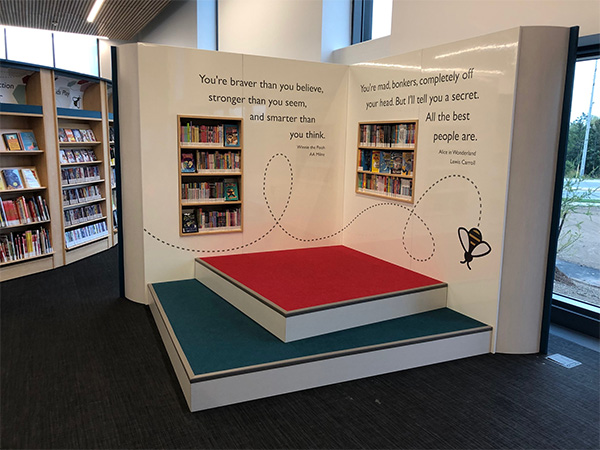
The Milton Public Library in Milton, Ontario joined Open Libraries and donated 30,000 books to the Internet Archive in response to the pandemic in 2020 to make material more accessible to the public. Photo Credit: Internet Archives Blog
Secure / Safe
Natural and man-made threats of the last decade have focused attention on protection of occupants and assets. Through comprehensive threat assessment, vulnerability assessment, and risk analysis, security requirements for individual buildings are identified, and appropriate reasonable design responses are identified for integration into the building design.
Given the mission of this building type, protection of occupants, assets, and building contents is of paramount importance. Protection of valued archival materials from fire and smoke, water, and inadequate environmental conditions, will require robust building and systems design, and reliable, durable, and integrated system sensors, monitors, alarms, and protection devices. In addition man-made threat security shall require controlled access and surveillance systems.
Consider entrances that do not face uncontrolled vantage points with direct lines of sight and driveway access to the entrance.
Utilize site barriers and setback distance, perimeter barriers and blast resistance, access control and intrusion detection, entrance screening, package screening and control, open areas that allow for easy visual detection by occupants, and minimized exposed glazing. See WBDG Secure / Safe—Security for Building Occupants and Assets.
Major circulation patterns should be clearly understood and logical. First-time visitors may have trouble navigating the safest exit route from the building. Consider using increased signage and/or providing safety information and a building directory in welcome brochures or on the facility's website. Also, review and evaluate safety plans on a regular basis. See WBDG Secure / Safe—Fire Protection and Secure / Safe—Occupant Safety and Health.
Fire protection system design becomes a critical design element involving extensive fire-rated construction and pressurized water delivery to sprinkler or water mist systems. Locate water main piping outside archive storage space to the extent possible. Fire protection systems must be designed to put out a fire as quickly as possible with minimal collateral damage to structure and contents.
Also include ability to rapidly vent heat and smoke from fires. This may be difficult to achieve for archive and record storage facilities located in basements and underground caverns.
If the program calls for multistory archive storage, consider the impact on fire fighters to access the fire, and to vent heat and smoke from upper stories.
Provide backup systems for all critical building functions for occupant safety and preservation of archival contents.
Consider synergies between sustainable strategies to conserve energy and right-sizing of security and emergency backup systems. See WBDG Balancing Safety/Security and Sustainability Objectives.
Sustainable
Sustainable design depends on building size, local climate, use profile, utility rates and discounts, and many other factors. Design strategies to achieve sustainability may involve:
- Energy load reduction by integrating the building with the site; adjustment of building orientation and fenestration; optimizing the building envelope (decreasing infiltration, increasing insulation), etc.
- Correctly sizing, optimizing, and commissioning the heating, ventilating, and air-conditioning systems
- Installing high-efficiency equipment including mechanical, electrical, plumbing, and lighting.
- Incorporating Low Impact Development Technologies principles in the site design.
- Incorporating water efficient fixtures on the interior and exterior to reduce overall water use.
- Providing healthy indoor environmental quality
- Providing natural daylighting and views to nature whenever possible
- Incorporating non-toxic materials, furnishings and finishes with low or no VOCs
Given the large roof and floor areas typical for this building type, consideration should be given to green or cool roof design, the application of alternative or renewable energy systems such as building-integrated photovoltaic systems to generate electricity, solar thermal systems to produce hot water for domestic hot water (DHW) or space conditioning, or geothermal heat pump systems to improve HVAC system performance.
Additional consideration should be given to the applications of other distributed energy sources, including microturbines, fuel cells, etc., that provide reliability (emergency and mission critical power) and grid-independence, and reduce reliance on fossil fuel grid power.
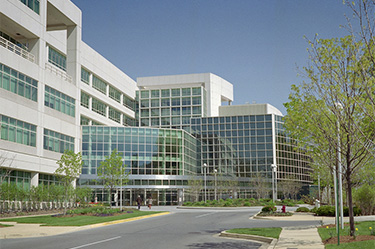

The National Archives II in College Park, Maryland, is the largest and most technically advanced archives building in the world. Designed by HOK architects and Ellerbe Becket engineers, the 1.8 million sf building includes records processing and storage areas (stacks), a five-level research center, conservation and special media laboratories, offices, conference, and training facilities, an auditorium, a cafeteria, a day care center, and an exercise facility. The central focus of the Archives II design was to create a building with state-of-the-art systems and environments that adhered to the strict conditions necessary for the long-term protection of records. Special attention was given to the design and construction of the records storage environments, the mobile shelving system, fire protection, and security. In addition, the finishes and materials used in the construction of the stacks were carefully studied and selected to minimize the exposure of the records to harmful contaminants. Photo Credit: Archives.gov
Emerging Issues
Given the long-term perspective required for an archives facility, the building will have to accommodate changing technologies for storage and handling of archival materials, change in the nature of the stored materials themselves, changes to building systems and materials over time, and possible change or redefinition of mission. See WBDG Productive—Design for the Changing Workplace and Productive—Integrate Technological Tools.
Electronic Media—The program should provide adequate space for housing and use of digital materials as more record storage is now being preserved in electronic form. Magnetic materials and optical storage media require specialized storage for conservation and preservation. Archival collections should receive special treatment and handling, and require specialized space temperature and humidity environments for preservation and storage.
Educational/Teaching Function—Consider program needs for outside group educational and teaching space(s), and for internal facility staff training and educational space(s). Such learning centers must be supported by access to electronic information resources, hardware tools, and associated productivity software. Consider implementing wireless communications technologies to allow archival staff to classify and locate archival materials using bar code technology without being bound to a desk.
Commissioning—With improved and complex building technologies and controls it is crucial that high-performance buildings are properly commissioned as part of a comprehensive quality assurance plan. The process of ongoing commissioning over the building life-cycle has shown to be effective. Federal agencies and private institutions are moving aggressively in the direction of mandating commissioning for all high-performance structures in their portfolios.
Modernization—An extensive inventory of older Archive and Record Storage facilities represents significant modernization challenges. Key areas of concern include: upgrading the exterior envelope, mechanical systems, telecommunications infrastructure, security, and interior finishes. Improving the workplace quality, energy performance, security, flexibility to accommodate tenant churn, maintenance overhead, and life-cycle expectancy are important objectives for modernizing these facilities. Appropriate preservation for buildings on, or eligible to be on, the historic registry is part of the modernization effort.
Relevant Codes and Standards
- Department of Defense Unified Facilities Criteria
- International Code Council
- National Fire Protection Association
- NFPA 232 Standard for the Protection of Records
- NFPA 232A Guide for Fire Protection for Archives and Record Centers
- NFPA 750 Standard on Water Mist Fire Protection Systems
- NFPA 13 Standard for the Installation of Sprinkler Systems
- NFPA 72 National Fire Alarm and Signaling Code
- NFPA 101, Life Safety Code®
- NFPA 1, Fire Code
- NFPA also publishes several codes and standards which cover specific aspects of fire protection and fire related hazards.
- U.S. Access Board
Other
- 36 CFR Part 1228, Subpart K - Facility Standards for Records Storage Facilities, Facility Approval and Inspection RequirementsDownload 2005-07a.pdf
- PBS-P100 Facilities Standards for the Public Buildings Service, GSA
- See various state and city governments that publish guidelines and standards for their particular holdings.
Additional Resources
WBDG
Building Types
Libraries, Academic Library, Presidential Library, Office Building, Parking Facilities, Warehouse
Space Types
Atrium, Auditorium, Automated Data Processing: Mainframe, Automated Data Processing: PC System, Conference/ Classroom, Food Service, General Storage, Library, Lobby, Mail Center, Office, Parking: Outside/Structured, Parking: Surface, Physical Fitness (Exercise Room), Private Toilet, Warehouse
Design Objectives
Aesthetics, Cost-Effective, Functional / Operational, Historic Preservation, Productive, Secure / Safe, Sustainable
Building Commissioning
Building Commissioning, Determine Project Performance Requirements, Commissioning Document Compliance and Acceptance, Owner's Role and Responsibilities in the Commissioning Process
Organizations and Associations
- The American Institute of Architects (AIA)
- Building Owners and Managers Association (BOMA)
- International Facility Managers Association (IFMA)
- International Living Future Institute
- National Archives and Records Administration
- Society of American Archivists
- U.S. Green Building Council (USGBC)
References
- National Archives and Records Administration
- Archives II Using Technology to Safeguard Archival RecordsDownload tip13.pdf Technical Information Paper Number 13 by the National Archives and Records Administration. 1997.
- Overview of Alternative Space Options for Libraries and Archives by Paul N. Banks, 1999.
- Special Challenges-Fire and Fire Suppression by Tom Goonan, 1999.
- Standards for Permanent Records Storage and Presidential Libraries by Richard Judson, 1999.
Others
- Energy Star®
- Guidelines for Accessible Archives for People with DisabilitiesDownload SAA%20Guidelines%20for%20Accessible%20Archives%20for%20People%20with%20Disabilities_2019_0.pdf by the Society of American Archivists. February 2019.
- High-Performance Commercial Buildings: A Technology RoadmapDownload 30171.pdf , U.S. Department of Energy, 2001.
- Open Library
- Zero Energy Buildings, Department of Energy - Office Energy Efficiency & Renewable Energy (EERE)



